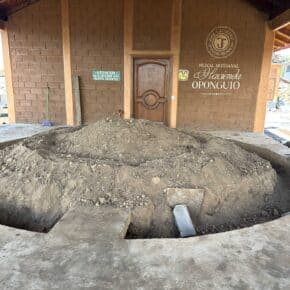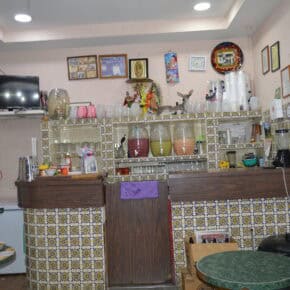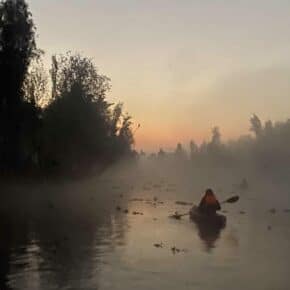[et_pb_section fb_built=”1″ _builder_version=”3.19.17″][et_pb_row _builder_version=”3.19.17″][et_pb_column type=”4_4″ _builder_version=”3.19.17″][et_pb_text _builder_version=”3.19.17″]
Exploring mezcal country is always exciting– winding up and down mountain roads, taking in the impossibly breathtaking vistas from cliff sides as new expansive landscapes open up on the road ahead. Getting lost and asking for directions, or letting an inner voice dictate which route to take can often lead to new discoveries, but it can also lead to frustration, and sometimes situations that can feel less than safe. Not for the faint of heart, mezcal country is always an adventure, but it doesn’t have to be such a challenge to find producers who are hoping to receive visitors. With a simple yet deeply effective program, Michoacan is leading the way in the development of the Ruta De Mezcal.
[/et_pb_text][/et_pb_column][/et_pb_row][et_pb_row _builder_version=”3.19.17″][et_pb_column type=”4_4″ _builder_version=”3.19.17″][et_pb_text _builder_version=”3.19.17″]
Road signs are the responsibility of the government, but in an area where local unions and coalitions often get more done than official government institutions, the community has taken it upon themselves. In an effort to encourage tourism Michoacan’s coalition of mezcal producers decided to be proactive about their signage. The signs feature the name and logo of the producer as well as the municipality and the Ruta De Mezcal symbol. They are posted on the main highways and side roads directing drivers toward the vinatas, taking most of the guesswork out of getting there. Organized tours are offered to help generate funds that, combined with the investment of producers, is the budget for putting up the signs.
[/et_pb_text][et_pb_image src=”https://mezcalistas.com/wp-content/uploads/2019/08/IMG_2539.jpg” _builder_version=”3.19.17″][/et_pb_image][/et_pb_column][/et_pb_row][et_pb_row _builder_version=”3.19.17″][et_pb_column type=”4_4″ _builder_version=”3.19.17″][et_pb_text _builder_version=”3.19.17″]
It sounds so simple, but the signage is a game changer for the local industry. The majority of visitors are Mexican nationals on vacation, some of whom are intrigued by the now popular mezcal culture. While only hardcore agave nerds are willing to blindly drive around small mountain towns hunting for mezcal, vacationers driving to and from other destinations now have the opportunity to follow easy to understand signs, much like driving around wine country in the United States. The signs make it easy for people to explore while maintaining a sense of security, connecting with producers who want visitors.
[/et_pb_text][/et_pb_column][/et_pb_row][et_pb_row _builder_version=”3.19.17″][et_pb_column type=”4_4″ _builder_version=”3.19.17″][et_pb_text _builder_version=”3.19.17″]
Everyone benefits, from the casual mezcal tourist and producer who will sell a few bottles directly to new customers, to the stores and restaurants in the communities. Another bonus is the transparency the signs offer, since they often feature multiple logos where multiple brands are produced. Since the fundraising is self contained by the coalition, producers maintain autonomy, and are able to allocate their resources in ways that make the most sense for them.
[/et_pb_text][/et_pb_column][/et_pb_row][et_pb_row _builder_version=”3.19.17″][et_pb_column type=”4_4″ _builder_version=”3.19.17″][et_pb_text _builder_version=”3.19.17″]
While other states wait around for the government to put these signs up, Michoacan’s ruta de mezcal may be the most functional. Most mezcal producing states have their own ‘ruta de mezcal’ which is also usually organized by a coalition of local producers. Sometimes there’s a map, or a flyer, but it is far from what most people consider an official program, and oftentimes difficult to experience without a local guide. In other words, unless you already know where you are going and have a contact there, good luck working it out. In Oaxaca for instance, chances are slim outside of the main strip in Matatlan, that you would be able to find a palenque open to the public.
[/et_pb_text][/et_pb_column][/et_pb_row][et_pb_row _builder_version=”3.19.17″][et_pb_column type=”4_4″ _builder_version=”3.19.17″][et_pb_text _builder_version=”3.19.17″]
Without opening the massive can of worms about palenques being open to the public, or producers being kept secret as proprietary information of the brands they produce for, the point is simple: signage helps develop tourism. Areas that don’t want visitors to come obviously don’t need signs, but all of the communities throughout the mezcal producing regions of Mexico that do want to encourage visitors should seriously consider following Michoacan’s example.
[/et_pb_text][/et_pb_column][/et_pb_row][/et_pb_section]












Who picks which Palenques get a road sign?